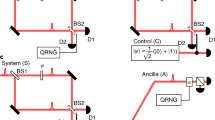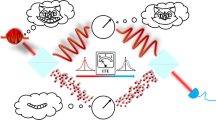Abstract
Two-particle interference is a fundamental feature of quantum mechanics, and is even less intuitive than wave–particle duality for a single particle. In this duality, classical concepts—wave or particle—are still referred to, and interference happens in ordinary space-time. On the other hand, two-particle interference takes place in a mathematical space that has no classical counterpart. Entanglement lies at the heart of this interference, as it does in the fundamental tests of quantum mechanics involving the violation of Bell's inequalities1,2,3,4. The Hong, Ou and Mandel experiment5 is a conceptually simpler situation, in which the interference between two-photon amplitudes also leads to behaviour impossible to describe using a simple classical model. Here we report the realization of the Hong, Ou and Mandel experiment using atoms instead of photons. We create a source that emits pairs of atoms, and cause one atom of each pair to enter one of the two input channels of a beam-splitter, and the other atom to enter the other input channel. When the atoms are spatially overlapped so that the two inputs are indistinguishable, the atoms always emerge together in one of the output channels. This result opens the way to testing Bell's inequalities involving mechanical observables of massive particles, such as momentum, using methods inspired by quantum optics6,7, and to testing theories of the quantum-to-classical transition8,9,10,11. Our work also demonstrates a new way to benchmark non-classical atom sources12,13 that may be of interest for quantum information processing14 and quantum simulation15.
This is a preview of subscription content, access via your institution
Access options
Subscribe to this journal
Receive 51 print issues and online access
$199.00 per year
only $3.90 per issue
Buy this article
- Purchase on Springer Link
- Instant access to full article PDF
Prices may be subject to local taxes which are calculated during checkout



Similar content being viewed by others
References
Bell, J. S. On the Einstein-Podolsky-Rosen paradox. Physics 1, 195–200 (1964).
Aspect, A. Bell's inequality test: more ideal than ever. Nature 398, 189–190 (1999).
Giustina, M. et al. Bell violation using entangled photons without the fair-sampling assumption. Nature 497, 227–230 (2013).
Christensen, B. G. et al. Detection-loophole-free test of quantum nonlocality, and applications. Phys. Rev. Lett. 111, 130406 (2013).
Hong, C. K., Ou, Z. Y. & Mandel, L. Measurement of subpicosecond time intervals between two photons by interference. Phys. Rev. Lett. 59, 2044–2046 (1987).
Rarity, J. G. & Tapster, P. R. Experimental violation of Bell's inequality based on phase and momentum. Phys. Rev. Lett. 64, 2495–2498 (1990).
Lewis-Swan, R. J. & Kheruntsyan, K. V. Motional-state Bell inequality test with ultracold atoms. Preprint at http://arXiv.org/abs/1411.0191 (2014).
Penrose, R. Quantum computation, entanglement and state reduction. Phil. Trans. R. Soc. Lond. A 356, 1927–1939 (1998).
Zurek, W. H. Decoherence, einselection, and the quantum origins of the classical. Rev. Mod. Phys. 75, 715–775 (2003).
Schlosshauer, M. Decoherence, the measurement problem, and interpretations of quantum mechanics. Rev. Mod. Phys. 76, 1267–1305 (2005).
Leggett, A. J. How far do EPR-Bell experiments constrain physical collapse theories? J. Phys. A 40, 3141–3149 (2007).
Bücker, R. et al. Twin-atom beams. Nature Phys. 7, 608–611 (2011).
Kaufman, A. M. et al. Two-particle quantum interference in tunnel-coupled optical tweezers. Science 345, 306–309 (2014).
Nielsen, M. A. & Chuang, I. L. Quantum Computation and Quantum Information (Cambridge Univ. Press, 2000).
Kitagawa, T., Aspect, A., Greiner, M. & Demler, E. Phase-sensitive measurements of order parameters for ultracold atoms through two-particle interferometry. Phys. Rev. Lett. 106, 115302 (2011).
Ou, Z. Y. Multi-Photon Quantum Interference (Springer, 2007).
Grynberg, G., Aspect, A. & Fabre, C. Introduction to Quantum Optics: From the Semiclassical Approach to Quantized Light (Cambridge Univ. Press, 2010).
Bonneau, M. et al. Tunable source of correlated atom beams. Phys. Rev. A 87, 061603 (2013).
Cronin, A. D., Schmiedmayer, J. & Pritchard, D. E. Optics and interferometry with atoms and molecules. Rev. Mod. Phys. 81, 1051–1129 (2009).
Schellekens, M. et al. Hanbury Brown Twiss effect for ultracold quantum gases. Science 310, 648–651 (2005).
Hilligsøe, K. M. & Mølmer, K. Phase-matched four-wave mixing and quantum beam splitting of matter waves in a periodic potential. Phys. Rev. A 71, 041602 (2005).
Campbell, G. K. et al. Parametric amplification of scattered atom pairs. Phys. Rev. Lett. 96, 020406 (2006).
Gross, C. et al. Atomic homodyne detection of continuous-variable entangled twin-atom states. Nature 480, 219–223 (2011).
Lücke, B. et al. Twin matter waves for interferometry beyond the classical limit. Science 334, 773–776 (2011).
Bookjans, E., Hamley, C. & Chapman, M. Strong quantum spin correlations observed in atomic spin mixing. Phys. Rev. Lett. 107, 210406 (2011).
Lewis-Swan, R. J. & Kheruntsyan, K. V. Proposal for demonstrating the Hong–Ou–Mandel effect with matter waves. Nature Commun. 5, 3752 (2014).
Beugnon, J. et al. Quantum interference between two single photons emitted by independently trapped atoms. Nature 440, 779–782 (2006).
Lang, C. et al. Correlations, indistinguishability and entanglement in Hong–Ou–Mandel experiments at microwave frequencies. Nature Phys. 9, 345–348 (2013).
Bocquillon, E. et al. Coherence and indistinguishability of single electrons emitted by independent sources. Science 339, 1054–1057 (2013).
Dubois, J. et al. Minimal-excitation states for electron quantum optics using levitons. Nature 502, 659–663 (2013).
Andersson, E., Fontenelle, M. & Stenholm, S. Quantum statistics of atoms in microstructures. Phys. Rev. A 59, 3841–3850 (1999).
Jaskula, J.-C. et al. Sub-Poissonian number differences in four-wave mixing of matter waves. Phys. Rev. Lett. 105, 190402 (2010).
Rarity, J. G. & Tapster, P. R. Fourth-order interference in parametric downconversion. J. Opt. Soc. Am. B 6, 1221–1226 (1989).
Treps, N., Delaubert, V., Maître, A., Courty, J. M. & Fabre, C. Quantum noise in multipixel image processing. Phys. Rev. A 71, 013820 (2005).
Morizur, J.-F., Armstrong, S., Treps, N., Janousek, J. & Bachor, H.-A. Spatial reshaping of a squeezed state of light. Eur. Phys. J. D 61, 237–239 (2011).
Ou, Z. Y. Quantum theory of fourth-order interference. Phys. Rev. A 37, 1607–1619 (1988).
Acknowledgements
We thank J. Ruaudel and M. Bonneau for contributions to the early steps of the experiment. We also thank K. Kheruntsyan, J. Chwedenczuk and P. Deuar for discussions. We acknowledge funding by IFRAF, Triangle de la Physique, Labex PALM, ANR (PROQUP, QEAGE), FCT (scholarship SFRH/BD/74352/2010 co-financed by ESF, POPH/QREN and EU to R.L.) and EU (ERC grant 267775, QUANTATOP, and Marie Curie CIG 618760, CORENT).
Author information
Authors and Affiliations
Contributions
All authors contributed extensively to this work.
Corresponding authors
Ethics declarations
Competing interests
The authors declare no competing financial interests.
Extended data figures and tables
Extended Data Figure 1 HOM dip visibility as a function of the integration volumes.
a, Visibility V as a function of the longitudinal integration interval Δvz. The transverse integration interval is kept constant at Δv⊥ = 0.48 cm s−1. b, Visibility as a function of the transverse integration interval Δv⊥. The longitudinal integration interval is kept constant at Δvz = 0.28 cm s−1. The red points mark the values discussed in the main text. Error bars denote the standard deviation of the statistical ensemble.
Extended Data Figure 2 Averaged number of incident atoms over the HOM dip.
a, Averaged atom number detected in  , nc, as a function of the propagation time τ. The mean value of nc(τ) is 0.20 with a standard deviation of 0.01. b, Averaged atom number detected in
, nc, as a function of the propagation time τ. The mean value of nc(τ) is 0.20 with a standard deviation of 0.01. b, Averaged atom number detected in  , nd, as a function of the propagation time τ. The mean value of nd(τ) is 0.19 with a standard deviation of 0.01. c, The cross-correlation between the output ports c and d (solid blue circles), displaying the HOM dip, is compared to 〈nc〉 · 〈nd〉 (open grey circles). Error bars denote the standard deviation of the statistical ensemble.
, nd, as a function of the propagation time τ. The mean value of nd(τ) is 0.19 with a standard deviation of 0.01. c, The cross-correlation between the output ports c and d (solid blue circles), displaying the HOM dip, is compared to 〈nc〉 · 〈nd〉 (open grey circles). Error bars denote the standard deviation of the statistical ensemble.
Rights and permissions
About this article
Cite this article
Lopes, R., Imanaliev, A., Aspect, A. et al. Atomic Hong–Ou–Mandel experiment. Nature 520, 66–68 (2015). https://doi.org/10.1038/nature14331
Received:
Accepted:
Published:
Issue Date:
DOI: https://doi.org/10.1038/nature14331
This article is cited by
-
Engineering multimode interactions in circuit quantum acoustodynamics
Nature Physics (2024)
-
Non-local temporal interference
Scientific Reports (2024)
-
Two electrons interacting at a mesoscopic beam splitter
Nature Nanotechnology (2023)
-
Protocol designs for NOON states
Communications Physics (2022)
-
Quantum gas microscopy for single atom and spin detection
Nature Physics (2021)
Comments
By submitting a comment you agree to abide by our Terms and Community Guidelines. If you find something abusive or that does not comply with our terms or guidelines please flag it as inappropriate.



